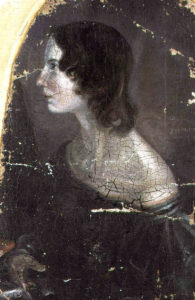
See image credit below.
Ooh! Heathcliff! That’s who I think of when I think of Emily Brontë’s 1847 novel, Wuthering Heights.
Sure, there’s Catherine and Nelly Dean and the moors and the intricately layered story within a story, but for me, it is all about Heathcliff, the quintessential dark, brooding, fiery, untamed Romantic hero. We know we shouldn’t be drawn to the rough-and-tumble Heathcliff. But, oh, how can we can help it?
I love the novel’s opening – as Mr. Lockwood, Heathcliff’s new tenant at the lofty estate Thrushcross Grange, recounts his “welcome” by Heathcliff and his hearth-side dogs, surlier even than their master. This scene is quickly followed by Lockwood’s haunting night spent at Wuthering Heights – the nightmares to which he succumbs, the tree branch banging incessantly against the window, the ghostly appearance of Catherine. If those scenes don’t draw you into a novel, you might as well give up, dear reader.
In a way, I guess you could say Wuthering Heights is a ghost story – for certainly Catherine haunts Heathcliff throughout the novel. Indeed, it is a spooky but thoroughly compelling experience to read Wuthering Heights, drawn in as we are by the Lockwood’s mysterious visits to Wuthering Heights.
As Nelly (the very definition of an “unreliable narrator”) begins to weave her yarn for Lockwood, we’re drawn in further still, yearning to know who Catherine Earnshaw is, to unlock the puzzle of the forbidding Heathcliff.
I first read Wuthering Heights when I was in junior high. It was one of the classics my mother and I read together one summer. I’d read a book first – Jane Austen’s Pride and Prejudice, Charlotte Brontë’s Jane Eyre, her sister’s Wuthering Heights – and when I had finished, my mother would take her turn.
At that young age and at that first reading, I fell for Nelly’s version of events – hook, line, and sinker. It wasn’t until I read the novel again (and again) and began to really study it that I discovered just how untrustworthy Nelly was, how she was not just an innocent bystander to Catherine and Heathcliff’s doomed romance but perhaps the cause of the bitter outcome. Perhaps if Nelly had not played the role she did, Catherine and Heathcliff – those ill-fated lovers – would have fulfilled their love.
But then we wouldn’t have Wuthering Heights, would we?
Wuthering Heights is Emily Brontë’s only novel, published under the pseudonym “Ellis Bell.” Brontë died the following year at age thirty from tuberculosis. After she died, her sister Charlotte edited Wuthering Heights and had a second edition published in 1850.
The novel sparked strong reactions from nineteenth-century readers. The English poet and painter Dante Gabriel Rossetti called it “A fiend of a book – an incredible monster. . . . The action is laid in hell, – only it seems places and people have English names there.”
The book is indeed fiendish, from its brooding hero and vexing heroine to the wild moors they call home. When the novel opens and Lockwood visits Heathcliff at Wuthering Heights and encounters the wild curs, it’s as if he is face to face with Cerberus, the hound of Hades. What an introduction to Wuthering Heights – the place and the novel!
You can read Wuthering Heights online at Project Gutenberg, but you’ll definitely want to have a hard copy
of this marvelous, enduring novel. As you read, it can help to consult a family tree, a relationships map, or a timeline.
Want to know more about Emily Brontë, Wuthering Heights, and the Yorkshire moors? Check out Mental Floss’s “10 Things You May Not Know about ‘Wuthering Heights.’” For links to numerous scholarly resources on Emily Brontë and Wuthering Heights, visit The Victorian Web. For more on Emily Brontë and her family, read the StoryWeb post on her sister’s novel Jane Eyre. You’ll definitely understand why their brother, Branwell, has often been said to be the inspiration for Hindley Earnshaw, Catherine’s older brother. And finally, you’ll want to visit the moors.
When Emily Brontë died just a year after Wuthering Heights’ first publication, she thought the book had been a failure. Little could she have known that it would go on to become one of the best-known and, unlikely as it seems given its haunting, “fiendish” qualities, one of the most beloved novels in the English language. Long live Heathcliff!
Podcast: Play in new window | Download
Subscribe to StoryWeb in iTunes.Listen to the podcast in Stitcher.
Image Credit: A portrait of Emily Brontë, made by her brother Branwell, https://commons.wikimedia.org/wiki/File:Emily_Bront%C3%AB_cropped.jpg.
